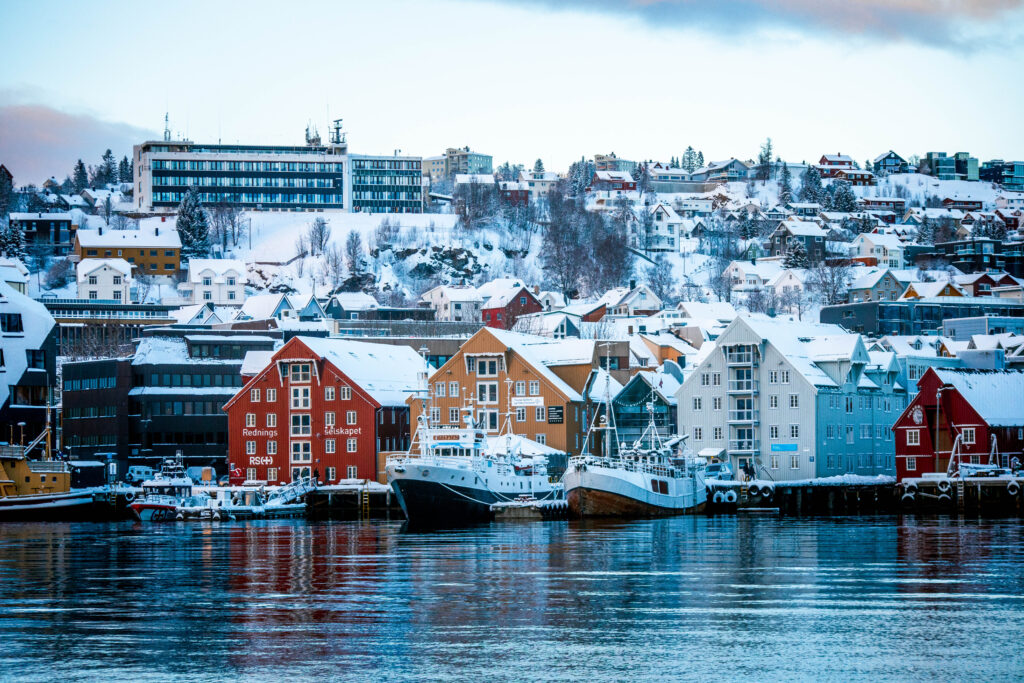VISIT Norway
Defined by dramatic fjords, snowy peaks, and Arctic light shows, Norway is a haven for nature lovers. This is Nordic wilderness at its finest.
Currency
NOK - Norwegian krone (1NOK ≃ 0,085€ ≃ 0,1$ ≃0,07£)
POPULATION
5,6 millions
MAIN LANGUAGES
Norwegian, Sámi
AREA
385,207 km²
TIME ZONE
UTC+1 / UTC+2
FLAG
🇳🇴
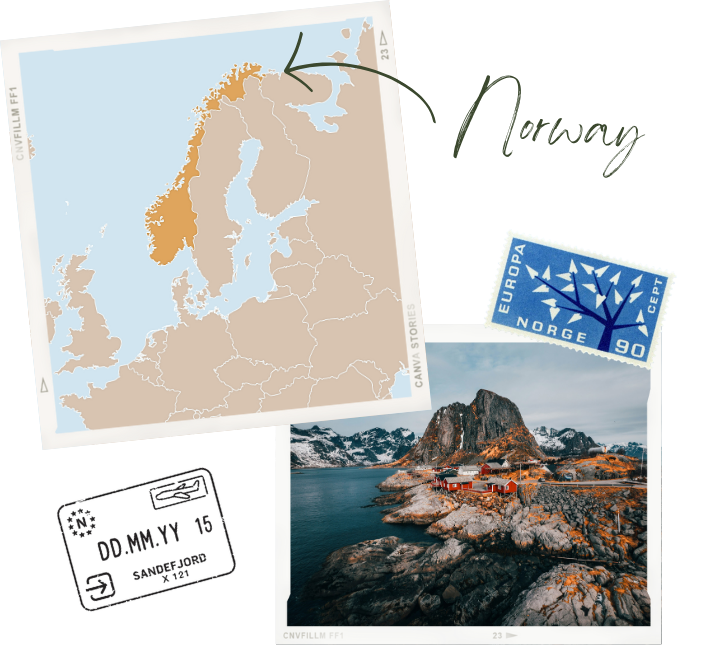
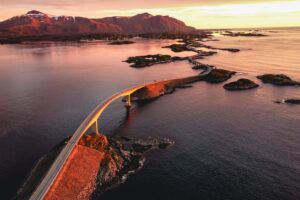
DRIVE THE ATLANTIC ROAD
This scenic road trip along the Atlantic Ocean Road links islands via twisting bridges and offers epic views.

SEE THE NORTHERN LIGHTS
Head north to places like Tromsø or the Lofoten Islands in winter for a chance to witness the Aurora Borealis, dancing across Arctic skies.
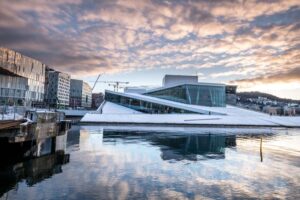
EXPLORE OSLO
Norway’s capital blends modern design and nature. Don’t miss the Vigeland Sculpture Park, the Munch Museum, or the Opera House by the water.
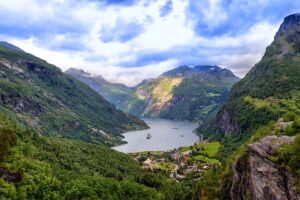
CRUISE THROUGH THE FJORDS
Norway’s world-famous fjords like Geirangerfjord and Nærøyfjord offer jaw-dropping scenery. A boat cruise lets you admire cliffs, waterfalls, and dramatic landscapes.
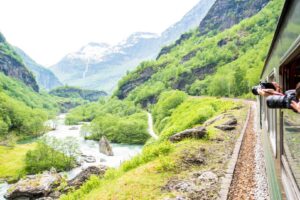
RIDE THE FLÅM RAILWAY
One of the steepest train lines in the world, the Flåm Railway winds through tunnels, waterfalls, and deep valleys in a breathtaking journey.
Pick a Norwegian destination
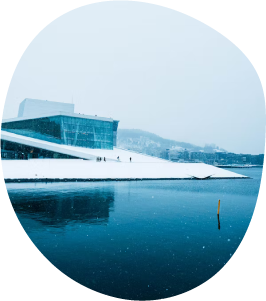
Oslo
Capital of Norway, blending Nordic modernity with fjord views and rich Viking heritage.
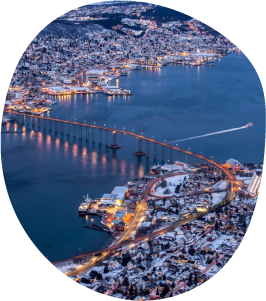
Tromsø
Arctic city known for Northern Lights, midnight sun, and vibrant polar culture.
Prepare your trip to Norway
💡 Why visit Norway?
Norway is a land of dramatic natural beauty, famous for its deep fjords, towering mountains, and pristine wilderness. From charming coastal towns and historic stave churches to the vibrant capital of Oslo, the country combines outdoor adventure with rich cultural heritage. It’s a dream destination for nature lovers, with highlights like the Northern Lights, scenic train rides, and world-class hiking.
🪪 Do I need a visa to visit Norway?
Norway is part of the Schengen area. Citizens of the EU, USA, Canada, Australia, and many other countries can enter visa-free for up to 90 days within a 180-day period. However, some nationalities do require a visa. It’s best to check with the nearest Norwegian embassy or consulate for the most up-to-date information specific to your situation.
IMPORTANT NOTE: The information below is provided merely as an indication and applies for short-term tourism visa purposes only. Before your trip to Norway, or if you are planning to come to Norway for another purpose (work, studies, …), check the official information on the European Commission website’s page about Schengen visa application: https://www.home-affairs.ec.europa.eu/
⏳ Visa-free but limited to maximum 90 days for a period of 180 days if you are a citizen of one of the following countries: Albania; Andorra; Antigua and Barbuda; Argentina; Australia; Austria; Bahamas; Barbados; Belgium; Bosnia and Herzegovina; Brazil; Brunei; Bulgaria; Canada; Chile; Colombia; Costa Rica; Croatia; Czechia; Denmark; Dominica; El Salvador; Estonia; Finland; France; Georgia; Germany; Greece; Grenada; Guatemala; Honduras; Hong Kong; Hungary; Iceland; Israel; Italy; Japan; Kiribati; Kosovo; Latvia; Liechtenstein; Lithuania; Luxembourg; Macau; Malaysia; Malta; Marshall Islands; Mauritius; Mexico; Micronesia; Moldova; Monaco; Montenegro; Netherlands; New-Zealand; Nicaragua; North Macedonia; Norway; Palau; Panama; Paraguay; Peru; Poland; Portugal; Romania; Saint Kitts and Nevis; Saint Lucia; Saint Vincent and the Grenadines; Samoa; San Marino; Serbia; Seychelles; Singapore; Slovakia; Slovenia; Solomon islands; South Korea; Spain; Sweden; Switzerland; Taiwan; Timor-Leste; Tonga; Trinidad and Tobago; Tuvalu; Ukraine; United Arab Emirates; United Kingdom; United States of America; Uruguay; Vatican; Venezuela
🛂 Visa required if you are a citizen of one of the following countries: Afghanistan; Algeria; Angola; Armenia; Azerbaijan; Bahrain; Bangladesh; Belarus; Belize; Benin; Bhutan; Bolivia; Botswana; Burkina Faso; Burundi; Cambodia; Cameroon; Cape Verde; Central African Republic; Chad; China; Comoros; Congo; Congo (Dem. Rep); Cote d’Ivoire (Ivory Coast); Cuba; Djibouti; Dominican Republic; Ecuador; Egypt; Equatorial Guinea; Eritrea; Eswatini; Ethiopia; Fiji; Gabon; Gambia; Ghana; Guinea; Guinea-Bissau; Guyana; Haiti; India; Indonesia; Iran; Iraq; Jamaica; Jordan; Kazakhstan; Kenya; Kuwait; Kyrgyzstan; Laos; Lebanon; Lesotho; Liberia; Libya; Madagascar; Malawi; Maldives; Mali; Mauritania; Mongolia; Morocco; Mozambique; Myanmar; Namibia; Nauru; Nepal; Niger; Nigeria; North Korea; Oman; Pakistan; Palestine; Papua New Guinea; Philippines; Qatar; Russia; Rwanda; Sao Tome and Principe; Saudi Arabia; Senegal; Sierra Leone; Somalia; South Africa; South Sudan; Sri Lanka; Sudan; Suriname; Syria; Tajikistan; Tanzania; Thailand; Togo; Tunisia; Turkey; Turkmenistan; Uganda; Uzbekistan; Vanuatu; Vietnam; Yemen; Zambia; Zimbabwe
⛅ When is the best time to visit Norway?
❄️ December – February: Winter is ideal for snow-based activities, especially in northern regions like Tromsø and the Lofoten Islands. Expect snow, short days, and a good chance to see the Northern Lights. Temperatures in Oslo range from -7°C (19°F) to 0°C (32°F), while it’s colder further north.
🌱 March – May: Spring sees the snow begin to melt, especially in the south. It’s a quieter time with blooming landscapes and longer days, ideal for scenic drives and city sightseeing.
☀️ June – August: Summer brings long days and even midnight sun in the north. Temperatures in Oslo average between 13°C (55°F) and 22°C (72°F). It’s peak tourist season, with great conditions for hiking, cruising the fjords, and enjoying outdoor festivals.
🍂 September – November: Autumn offers cooler temperatures and stunning fall colors. The crowds thin out, and the first snow may appear in the mountains. Days become shorter, especially in the north, making it a good time to begin Northern Lights season.
🚉 How to get around Norway?
Getting around Norway is straightforward, although distances can be long:
🚌 Buses: Buses are reliable and connect most towns and rural areas. Long-distance companies like Vy Buss and Nor-Way Bussekspress operate between major destinations. Regional buses serve fjord villages and mountain regions but may have limited service.
🚂 Trains: Norway’s train system is modern and scenic, especially routes like the Oslo–Bergen line and the Flåm Railway. Trains are clean, comfortable, and offer stunning views of mountains, lakes, and valleys.
🚗 Car Rental: Renting a car offers flexibility and is ideal for exploring remote areas and fjord routes. Roads are generally in excellent condition, though mountain passes can be closed in winter. An International Driving Permit (IDP) is not required if your license is in Latin script.
💳 Can I use bank cards or cash for payments in Norway?
Norway is a nearly cashless society. Most payments are done by debit or credit card, even for small purchases. Visa and Mastercard are widely accepted. American Express is accepted in some places but not everywhere. Some shops and services do not accept cash at all.
🔌 What type of plugs and voltage does Norway use?
Norway uses plug types C and F, both with two round pins. The standard voltage is 230V and the frequency is 50Hz.
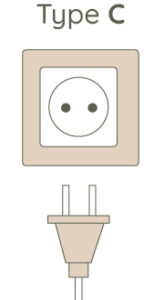
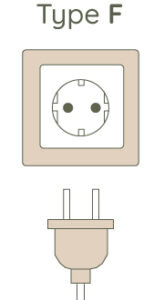
If needed, you can order an universal travel plug adapter here.
🪙 Is tipping customary in Norway?
Tipping is not mandatory but appreciated. In restaurants, rounding up the bill or leaving around 5-10% is common if the service was good. Tipping taxi drivers and hotel staff is not expected but welcomed.
🥛 Is it safe to drink tap water in Norway?
Tap water is safe to drink throughout Norway.
📅 When are public holidays and store closing days in Norway?
In Norway, most stores are closed on Sundays. There are 10 national public holidays in Norway:
- New Year’s Day (January 01)
- Maundy Thursday, Good Friday and Easter Monday (dates vary)
- Labour Day (May 01)
- Constitution Day (May 17)
- Ascension Day and Whit Monday (date varies)
- Christmas Day (December 25)
- Boxing Day (December 26)
On these days, most businesses and offices will be closed, and many attractions may be shut or have limited opening hours.
🚦 What are the speed limits in Norway?
In Norway, traffic drives on the right-hand side of the road. The main speed limits are as follows:
- 50 kph / 30 mph in urban areas
- 90 kph / 56 mph on main roads outside built-up areas
- 110 kph / 68 mph on motorways
During adverse weather (rain, fog, etc.), the speed limits are lowered.
💬 What are some basic Norwegian words I should know?
- Hello (informal) = Hei
- Good day = God dag
- Goodbye = Ha det
- Yes = Ja
- No = Nei
- Thank you = Takk
- Please = Vær så snill
- You’re welcome = Vær så god
- Excuse me = Unnskyld
- Day = Dag
- Night = Natt
- Good evening = God kveld
- Goodnight = God natt
- Mister = Herr
- Ma’am = Fru
- Street = Gate
- Road = Vei
💡 Tip: With the GoogleTranslate app, you can download the Norwegian language to use it even offline!
🛡️ Is it safe to travel in Norway?
Norway is considered very safe for travelers. Crime rates are low, and infrastructure is excellent. As always, basic precautions are advised:
Secure Your Belongings: Pickpocketing is rare but can happen in touristy areas.
Emergency Numbers: Dial 112 for all emergency services in Norway.

